
Original Link: https://www.anandtech.com/show/2545
PC Power & Cooling Silencer 500W
by Christoph Katzer on June 9, 2008 2:00 AM EST- Posted in
- Cases/Cooling/PSUs
Introduction

We have already reviewed several PC Power & Cooling products on AnandTech, and we even had the chance earlier this year in Las Vegas to interview their founder Doug Dodsen. Today we will be looking at their latest product, an enhancement of their Silencer series. At 500W, the new Silencer settles in the middle of the existing 420W and 610W versions. We encountered our first Silencer last year, which performed very well and even managed to snag our 2007 PSU of the Year award. We will see if the 500W version can stack up to its predecessor.

The 3.3V and 5V rails are rated somewhat lower than we're used to, but there's nothing to worry about since modern systems don't place a huge load on these rails anymore. The 12V rail is rated at 35A, which means you can pull up to 420W. The UL number shows PC Power & Cooling; this is no surprise since even though this unit is not made by PCP&C, the company has been around long enough to have their own registration with UL. New to the label is the "Part of the OCZ Technology Group" note below the PCP&C name, one of several outward changes since the acquisition last year.
Appearance

The package comes with pictures and facts on it, another change since the OCZ purchase. Previously, PCP&C shipped all power supplies in white boxes, and OCZ is obviously a bit more concerned with the marketing angle. There are screws, a manual in three languages, and a power cord in the box. The power supply comes in a black coating we are familiar with from many other PCP&C models.

Also familiar is the 80mm fan in the back that exhausts hot air from the unit. We found an Adda sleeve-bearing fan, which can be quiet at lower RPMs but can also get very loud if necessary. We'll see if that's a concern later in our testing.
Cables and Connectors
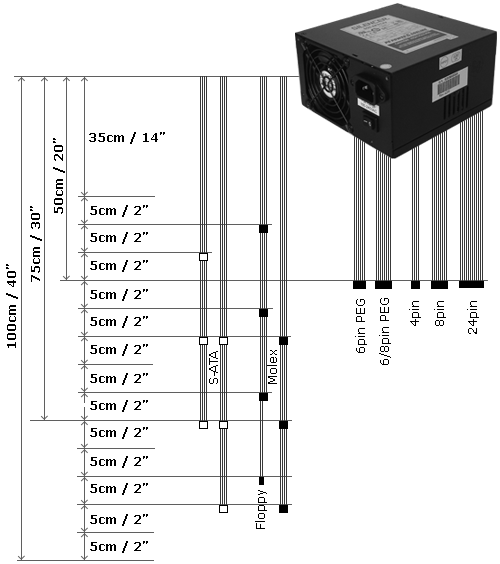
PCP&C generally tries to position the connectors such that users have better connectivity with fewer cables hanging around. There are six Molex and six SATA connectors attached, providing users a selection of distances to the power supply. One harness features an additional floppy connector. There is a 24-pin connector and a 4-pin/8-pin connector for the motherboard. PCI-E graphics cards can be powered by the two 6-pin PEG connectors, one of which can convert to an 8-pin connector. You will be able to run an SLI setup, provided each card requires only one 6-pin connector; alternately, you can run a single more demanding card that requires two 6-pin connectors or one 6-pin and one 8-pin connector. That's not too shabby for a 500W PSU!
Internals

Opening the unit reveals a typical Seasonic design, but this time the heatsinks are arranged to better accommodate the 80mm fan setup. Seasonic normally cools this design with a 120mm fan blowing at the top of the heatsinks, so the heatsinks benefit in that case from a shape that will allow air to pass through vertically. This time the air comes from the sides and the back so they can be closed to the top.
There is a Nippon Chemi-Con cap installed on the primary circuitry, and the secondary features wildly placed OST RLX and RLS series capacitors. OST are often used by Seasonic, but they don't have the best reputation. In addition the caps are placed in between the cables and look like wild mushrooms growing in all directions. Internal appearance and performance are different areas, and it's possible to have an "ugly" interior while still providing high quality power. We'll see if that's the case here in a moment.
Testing with the Chroma ATE Programmable Load
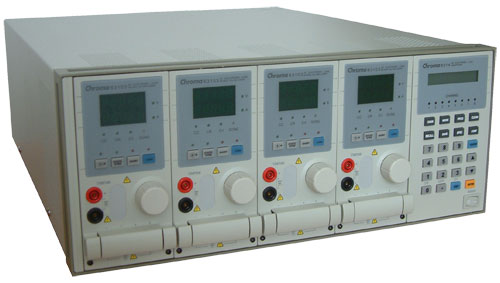
Our test equipment consists of two Chroma programmable DC Loads that enable us to test power supplies with an output of up to 1500W. The biggest advantage of the Chroma DC Loads is simply the high precision it provides. It can measure differences as small as 0.001V and 0.0001A, which will provide us with best-in-class results.
When programming the Chroma with specific amounts of load calculated according to the ATX norm, we are able to load power supplies to an exact percentage. We can now show results at every specific percentage needed. To get the best overview of a power supply, we load each unit with 10%, 20%, 50%, 80%, 100%, and 110% of the specified output. This is easy to calculate for a 1000W power supply: the 10% load is 100W and 110% load is 1100W. Remember that this is the amount of power the PSU delivers; due to inefficiencies, a power supply will actually draw more power from the wall.
Note: If you would like to know more about our testing methodology, equipment, and environment, please read our PSU testing overview.
We have added an additional 10% on the highest load to see how the units perform with overload. This test will be performed in all future reviews. The overload test is performed at room temperature as well as under more stressful conditions; to ensure we are not too cruel to the power supplies, we will keep the ambient temperature at 50°C in the stress test. Experience shows that many units can stand the overload at room temperature but will experience problems with higher temperature and overload together. Only the best-built units will survive this.
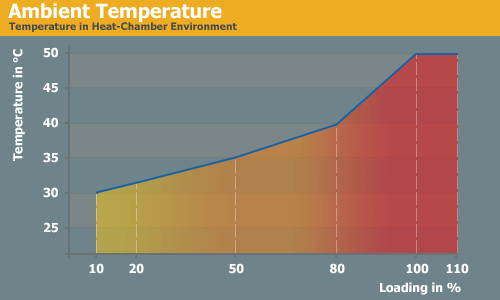
The Testing Environment
There is one flaw in testing power supplies with programmable loads while trying to measure the sound pressure levels at the same time. Because the programmable loads get very loud, there is no chance of hearing the power supply on the test stand. In order to make accurate measurements of the noise levels we needed a way to separate the test unit and the programmable loads. Our solution was to build a very thick box around the unit.
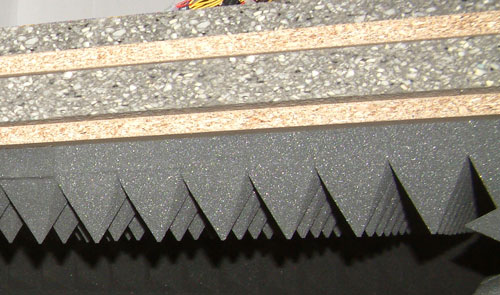
We concluded that a five-layer box with a total thickness of 6" (15cm) containing two layers of wood and three layers of special foam would suffice. It is designed as a box within a box. The inner box does not touch any part of the outer box, making it difficult for acoustic noise to pass through in the form of vibration. Each box is isolated on both sides with a layer of heavy foam that is normally used to insulate engines. On the inside we have an additional layer of 4" (10cm) thick pyramidal foam on every side of the box to eliminate the acoustic waves coming from the test object as well as we can.
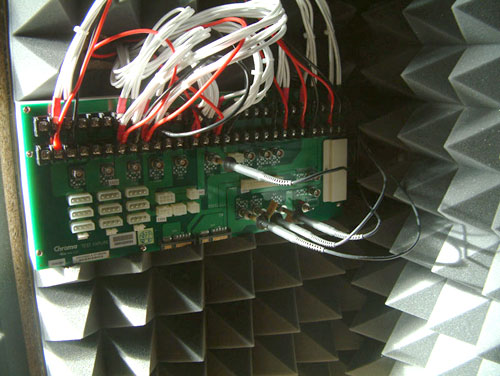
To ensure a completely closed system we installed the printed circuit board that the connectors of the power supply are attached to inside the anechoic room/box. In other box designs, you would need to put all the cables through the wall. Unfortunately, that would result in the inside of the box not being fully isolated anymore. Our design keeps everything that needs to be connected inside of the box and maintains isolation.
DC Outputs
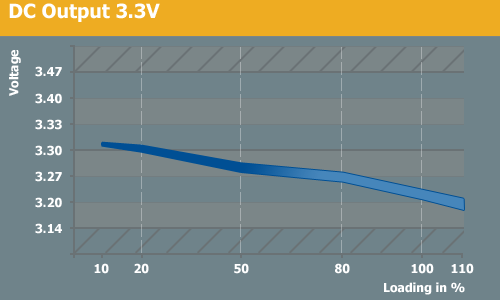
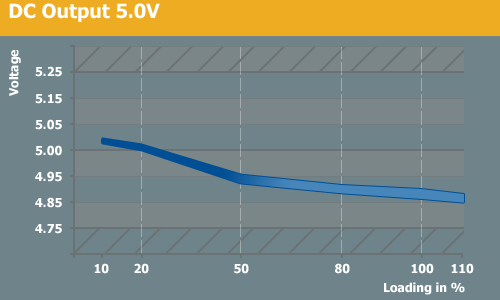
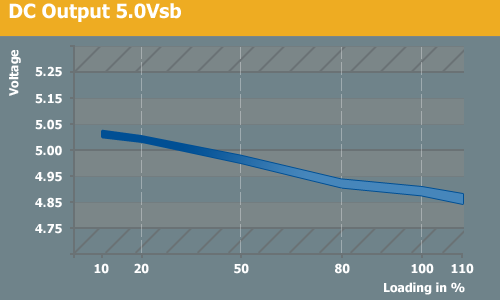
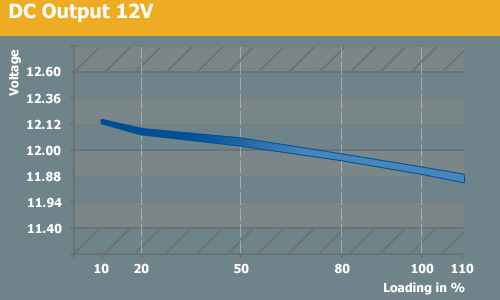
The lower voltage rails drop slightly more than 3% below the ideal amount, while the 12V rail stays a bit closer to spec. The 3.3V and 5V rails start right at spec (just slightly higher); they then drop slightly, reaching just below 3.20V and 4.85V at maximum load. The 12V rail starts high at 12.14V and drops to 11.87V with 10% overload, easily staying in spec. These voltage drops will not cause any problem at all when this PSU is in use in a system.
Efficiency
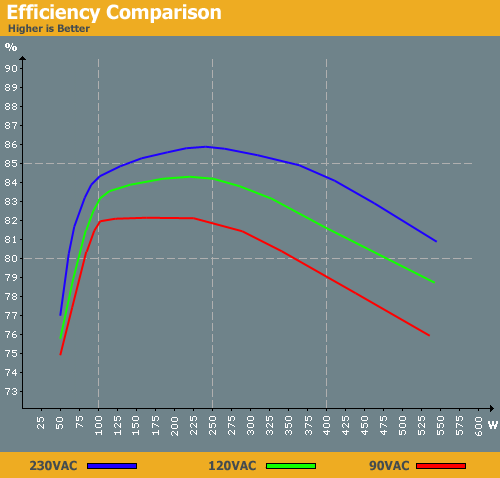
We are using a smaller version of our efficiency comparison graphic to improve chart readability. It is only for 600W or less power supplies and provides more detail in the lower power ranges. With 230VAC input, the Silencer 500W starts at 77% efficiency loaded with 50W. A 100W load improves efficiency to a much better result of 84%, and we reach maximum efficiency of 86% at medium load. Efficiency then slowly decreases to 81% with 550W load. As always, efficiency is lower with 120VAC and especially with 90VAC, reaching 84% and 82% maximum respectively.
Power Factor Correction
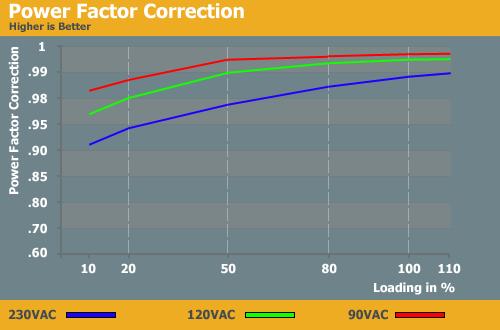
The power factor correction on the other hand is as always better with lower input voltages. While the .99 with 230VAC appears low compared to the 120VAC and 90VAC results, it is still a good result - though it is only attained with maximum load.
Fan Speed
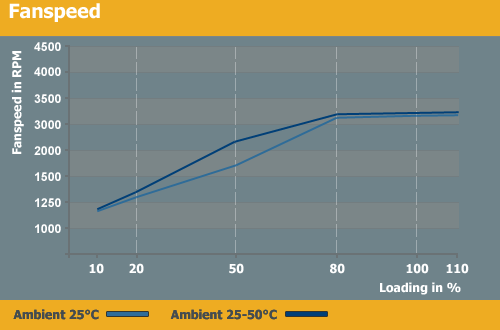
The fan starts rotating at 1240 RPM, which is already somewhat high. It would be perfectly acceptable to keep the fan at this speed until higher loads, since the power supply doesn't really get much warmer inside until higher loads. However, as the graphs show the fan starts turning faster with every single step of load we applied. The maximum 3200 RPM is reached quite fast at only 80% of load, which is clearly not necessary. PCP&C continues to ascribe to the "better safe than sorry" approach to PSU cooling - not a bad idea, but also not necessary at some point.
Acoustics
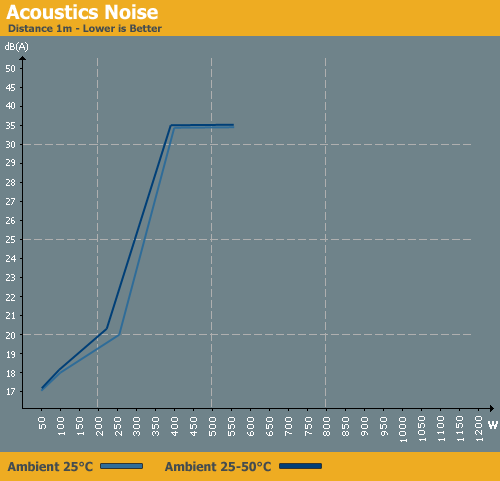
The acoustics table shows it clearly that there is a heavy increase in acoustic noise during operation. We could live with the 20dB(A) reached at a medium load of 250W, but 35dB(A) with just a little more than 350W more isn't something we would be happy with. To put things in perspective, we've tested other power supplies that deliver over 1000W of power without reaching such a high noise level. We're not at all convinced by the "Silencer" name in this case.
Conclusion
The Silencer 500 leaves a great impression when it comes to external appearance and packaging, but the story changes once we begin testing with our Chroma. The performance isn't bad - in fact, it's quite good - but somehow the Silencer 500W does not have anything to do with silence when it comes to reasonable loads. The build quality is very good as always, though it seems the secondary capacitors could have been placed better and OST might have not have been the best choice. Our real complaint lies with the fan, however.
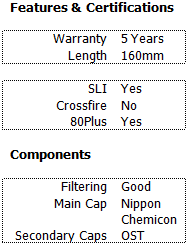 |
From the performance side of the equation, the power supply does well with minor flaws in output stability. The efficiency is also good, reaching up to 86% with 230VAC and up to 84% with 120VAC. The optimal load for this power supply is 100 to 200W of power - about what you would need for a decent system with a 9800 GTX paired with an Intel E8500 or Q9300. For that sort of system, acoustic noise levels should remain acceptable as well.
At loads above 200W, however, acoustic noise becomes a real concern. There is simply no need to cool a 500W power supply with a 3200 RPM fan and a resulting 35dB(A). We have tested many midrange power supplies; frankly, there aren't any that reach similar noise levels. PCP&C should definitely give a second thought to noise; with small adjustments to the fan controls, we see a chance for this unit to compete with other silent units.
In terms of pricing, we have the next surprise, as the Silencer 500 will be a bargain (relatively speaking). PCP&C is known for being more expensive than competing models, but this time they're competitive with similar quality 500W offerings. The price in the US is $90, and we're told it will be an incredible 60 EUR over in Europe. Most other 500W units are at least 15-25 EUR more. Antec Earthwatts, Corsair, Seasonic, and Silverstone all have similar US prices, and they also run noticeably quieter. However, for 60 EUR there are almost certainly users who will be willing to overlook the minor flaws in voltage regulation; if you only use 250W of load (which will be easy unless you start overclocking components), you can also keep noise levels in check. The decision is as always yours, and pricing and availability will very likely play a deciding role.

























